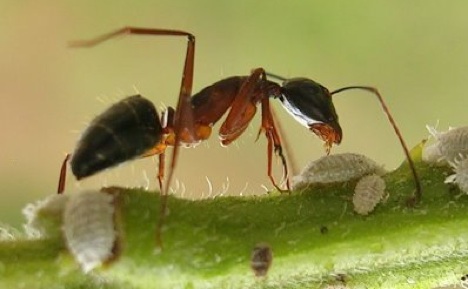The Dramatic Life of Camponotus saundersi
Reproduction
The life cycle and reproductive mechanisms of Camponotus
saundersi is very similar to that of any ant in the Genus
Camponotus. The queen ant of the colony is the only one
capable of producing eggs. Many sterile female workers are also part of
the colony, but their duty is to aid the queen in producing as many eggs as she can by protecting her and bringing her
food (Jacobs 2014). The queen’s sole duty is to produce eggs and
she is fertilized by the winged males. The fertilization process
is brief, after which the male does not survive. When
environmental conditions are just right during late winter and
early spring, the winged males and winged females emerge from
mature colonies and create a swarm. This is when the mating
process takes place. Exchanged pheromone communications also
help to trigger this ant swarm. The winged female will mate with
several different winged males, remaining fertile for the rest
of her life after this first fertilization event, by storing
excess sperm in her body (Pararas-Carayannis 2008).
Once
fertilized, the female ant breaks off her own wings and will search
for a suitable nesting site where she will produce between 15
and 20 eggs at a time. This suitable nesting site will soon be a
new ant colony. These first eggs produced will later become her
sterile female workers (Jacobs 2014). The first time the female
ant reproduces, her offspring are small and feed off of the
reserves of food in her body or the remnants of her wings. The
queen can now use a stored supply of sperm in her own body from
the first mating process to produce eggs that are either
fertilized or unfertilized. Fertilized eggs can also produce
winged female ants, which will potentially become queen ants in
their own colonies (Extension 2013).
The process
will repeat, but now the female will have worker ants to care
for her eggs. After the eggs are laid, the workers carry them
away where they protect, feed and raise the eggs even into the
larvae stage. To produce food for the larvae and the
queen, the worker ants feed on dead insects and regurgitate the
food. About 60 days are needed for the eggs to reach full
maturity and become worker ants (Jacobs 2014). While the workers
are taking care of the new eggs, they are also increasing the
size of the nest. They do so by creating new chambers in which
are used similar to how incubators are used. They create small
chambers near the top of the nest, which are warmed by the sun. This warmth helps the new larvae to grow faster. A humidity
gradient of twelve to fifteen percent is maintained in these
incubating environments. These chambers are referred to as
primary nests. The workers, new larvae and the queen all inhabit
the primary nest. The old larvae, winged males and winged
females are housed in what is referred to as the satellite
nests, in which there is no crucial humidity requirement
(Pararas-Carayannis 2008).
worker ants (Jacobs 2014). While the workers
are taking care of the new eggs, they are also increasing the
size of the nest. They do so by creating new chambers in which
are used similar to how incubators are used. They create small
chambers near the top of the nest, which are warmed by the sun. This warmth helps the new larvae to grow faster. A humidity
gradient of twelve to fifteen percent is maintained in these
incubating environments. These chambers are referred to as
primary nests. The workers, new larvae and the queen all inhabit
the primary nest. The old larvae, winged males and winged
females are housed in what is referred to as the satellite
nests, in which there is no crucial humidity requirement
(Pararas-Carayannis 2008).
Secretions from exocrine glands play a large role in the reproductive success of C. saundersi (Davidson et al. 2011). Without these chemical secretions and the proper environmental conditions, the initial swarm of ants in late winter and early spring would not take place (Pararas-Carayannis 2008). The chemical secretions also aid in the ability of males to attract females. This helps to further illustrate the value of chemical communication that has evolved among this genus (Davidson et al. 2011).
To see another reproductive life cycle in which an initial mating swarm takes place, click here. Otherwise, continue on to interactions to gain more knowledge of this incredible organism, or return home.